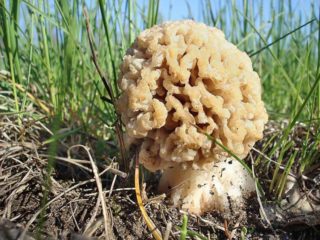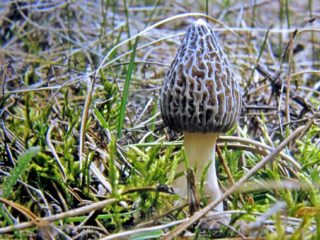Content
Every mushroom picker should know where to collect morels in the Moscow region, since many types of morels are not only edible, but also tasty. The widespread opinion that this variety is not suitable for consumption is based on the content of the poison gyrometrine in its composition, which, however, leaves the product along with water during the first boiling for 10-15 minutes.
Rules for collecting morel mushrooms in the Moscow region
Morels in the Moscow region have become one of those mushrooms that are actively hunted. Many mushroom pickers and simply curious residents have learned about the medicinal properties of this mushroom, and now everyone wants to get it not only for eating and preparing medicine, but also to plant it in their summer cottage.
Due to the large number of people interested, it is worth going to those places in the Moscow region where there are minimal harvest hunters. In addition, it is worth knowing that by the end of June there are not so many of these mushrooms, and in the fall they completely disappear.We should not forget that the morel can be easily confused with the common fungus, which is poisonous and grows in late summer and autumn, so many inexperienced mushroom pickers may confuse it with an edible specimen.
Don't forget about safety rules. If you are not exactly sure of the type of mushroom, you should not take it. Recently, mushroom pickers have been collecting strings and passing them off as edible morels. Representatives of this variety are distinguished by their appearance (very similar to brains), and they can be eaten only after very long heat treatment.
When do morels grow in the Moscow region?
You can collect morel mushrooms in the Moscow region as early as mid-April. But there are no exact dates; a lot depends on weather conditions. Therefore, experienced mushroom pickers advise going on a “quiet hunt” from April to mid-June.
In order not to make a mistake with the timing, it is worth paying attention to some signs associated with the appearance of the harvest in the Moscow region:
- The first grass appeared - the morel began to grow.
- The aspen has fluffed up its earrings - you can go out and pick mushrooms.
- Night blindness has bloomed - it's time to go out for morels.
Where to look for morels in the Moscow region
The list of places where morels grow in the Moscow region is shown on the mushroom map:
- New Grishino (Dmitrovsky district, in the north).
- Akulovo (a forest near Kubinka, where the Trasna River flows, as well as Sand Stream - not far from Moscow).
- Panino and Sandarovo (Chekhov).
- Lyubyatino, Amelfino, Shishkino (near Volokolamsk).
- Malaya Borshchevka (Ruchi in the Klin district, Sloboda).
- Pochinki, Danki (Serpukhov, Priokskie forests are some of the most mushroom places).
- Brekhovskaya, Tarakanovo (Egoryevsk).
- Kokovino, Oreshki (area of the Ozerninsky reservoir).
- Nazimikha, Toporkovo, Novaya Sloboda, Ulitkino (Fryazino).
- Zakharovo, Maryino (Electrogli).
- Tsvetochny, Puchkov, Malinovka, Novo-Spasskoye (Troitsk).
- Zosimova Pustyn, Machikhino, Belousovo, Trinity (near Naro-Fominsk).
- Gubino and Belozersky (Ramensky, forest, which is located directly near the airfield).
A map of morels in the Moscow region will help you navigate the mushroom places. The most reasonable solution would be to travel to the south or west of the Moscow region (on the presented map these places are circled in red). It is there that you can find forest plantations and forests, ridges and islands on which the desired species grows.
Where do morels grow in the Moscow region?
Representatives of the Morel family grow in any forest, they are even found in the capital's parks (Teply Stan). Therefore, in the Moscow region you can choose any forest where there are pine trees. Moreover, they should not form the basis of planting, since morels in the Moscow region still grow mostly in deciduous forests, and the presence of pine trees is simply a good addition to their growth and reproduction.
When choosing a place for a “quiet hunt”, you need to know several signs of where to collect morels in the Moscow region:
- You need to focus on places where there are sandy soils: they warm up faster and allow the mushrooms to “breathe”;
- loves culture and moisture, so it is best to choose plantings and hillocks that are heavily overgrown with grass;
- it also grows on peat soils, so the proximity of the swamp can also become a reference point for lovers of “quiet hunting”;
- You can fill a basket not only in the forest, but also in abandoned apple orchards, neglected summer cottages and along country roads.
Safety precautions for collecting morels in the forest
Despite the fact that the forests near Moscow are not taiga, even in them you can easily get lost. Therefore, to prevent this from happening, when collecting morels you need to follow a number of simple rules:
- You shouldn't go into the forest alone. Even if a mushroom picker goes alone, he must inform his friends and family about his intentions and the approximate time of return. It is also worth discussing the approximate route.
- You need to take with you a minimal, extremely necessary supply of things - matches, some food, water, a compass and a knife.
- A mobile phone will also come in handy. It must be fully charged when you leave home, with enough money in your account.
- If an elderly person or someone suffering from any disease goes to the forest, it is necessary to take medications with them, even if the time for taking them, in the opinion of the mushroom picker, will come after returning from a quiet hunt.
- For clothes, it is better to choose something bright and catchy. An excellent option is things with reflective elements.
- When moving through the forest, it is important to remember some features - broken trees, flowing streams, etc. This will help rescuers more accurately determine the location of the mushroom picker if he does get lost.
Conclusion
Morels are not uncommon in the Moscow region. Therefore, anyone can go out on a quiet hunt and replenish their supplies with these tasty, healthy mushrooms.











